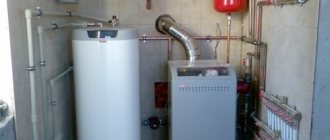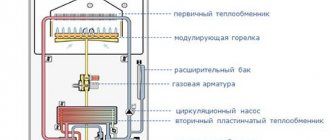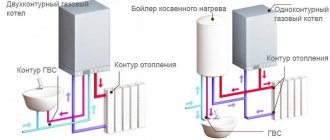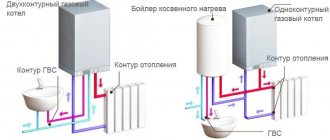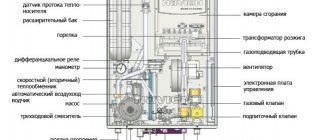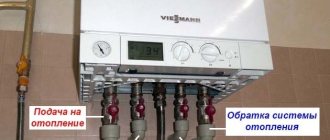Home |Useful articles |Double-circuit boiler in comparison with a single-circuit boiler and a gas water heater
Date: October 6, 2020
Comments: 1
In matters of water treatment in a private home, there is an eternal debate between universal and specialized approaches.
A universal view is to provide the home with heat and hot water using a double-circuit gas boiler that solves both problems simultaneously. The second option is specialization, when one unit (gas water heater) supplies hot water, and another (single-circuit boiler) handles home heating.
Specialists of the GradusPlus project, who have posted more than one material on their portal gradusplus.com about ways to save and optimize home heating, presented all the pros and cons of each of the schemes. They also determined why a single-circuit boiler and gas water heater are better and more comfortable, but not always.
Double-circuit gas boilers
Such boilers constructively separate the heating circuits of DHW and coolant, while sanitary water from the DHW circuit does not mix with technical water in the heating circuit. In our climate, they have two main operating modes:
- simultaneous maintenance of temperature in the hot water circuit and heating of the room in winter (or, if necessary, in cold summer);
- summer provision of hot water for household needs when heating is turned off (summer mode).
Operating modes can be controlled manually (for budget models) and automatically, depending on the situation outside the home (for advanced boilers). Double-circuit equipment is divided into two types: with a common or two separate heat exchangers.
Differences between boilers with one bithermal heat exchanger and two separate monothermal ones.
Types of heaters and boilers for apartments (including Khrushchev)
If we talk about gas heaters, they can be flow-through or storage. But in Russia, gas boilers are not widely used, because they are less convenient, cost more and take up a lot of space. They should only be installed if the gas supply is too weak. Mostly they install instantaneous gas heaters. You can find out how many sockets you need in the kitchen here.
Modern models may have a closed or open combustion chamber. Open ones are a little safer and require less paperwork during installation. They are needed if there is no chimney in the house. The latter are suitable if the old heater is being replaced with a new one, the chimney and gas supply have already been made and tested.
Suppliers offer 3 types of power. 17-20 kW is needed for a one-room apartment with 1 inhabitant. If a person takes a shower, there is no longer enough power to wash dishes. Devices with a power of 20-26 kW are indispensable for apartments. They provide 15 liters of water per minute at a temperature of 40 degrees. The power of an average heater is enough for a family of 4 people and an apartment with 1 shower and 2 sinks. A power of 26-28 kW is suitable for two-level apartments or houses. You can find out what kitchen hoods there are by following this link.
Boilers with double heat exchanger
This is the most compact and inexpensive design solution. The gas burner heats one heat exchanger, divided into two independent sectors for hot water and coolant. One circuit is inside the other. They are united only by the metal of the converter and do not mix in any way.
However, there are also significant disadvantages of the bithermal design. To increase efficiency, the sectors of the circuits are located very close and different-temperature fluid in them can strain and deform the entire structure. Corrosion in this system is also increased and requires high-quality water and coolant, otherwise the narrow channels will simply become overgrown with scale and become clogged.
Gas water heater for heating
Buiny wrote: This is intelligible.
One of the main differences between a column and a heating boiler is that the heat exchanger of the column has a specially made much (very much) higher hydraulic resistance. And it (the heat exchanger) is designed for completely different ratios of the temperature difference between water at each local point and gas combustion products. And nothing can change this difference. A column will always remain a column.
And without a large pressure drop across the heat exchanger of the column, it simply will not turn on (unless, of course, the “frog” or automation is working).
Further.
The boiler (especially older models such as VPG) may lack safety systems that must be installed in the boiler:
- Ionization flame control.
- Traction sensor.
- Carbon monoxide sensor.
- Monitoring the operation of the circulation pump.
- Coolant flow sensor.
- Supply temperature sensor (exit from heat exchanger)
- Emergency pressure relief valve (demolition valve).
- Automatic air vent from the heat exchanger.
- Gas fittings modulate the power of the burner, metering the gas supply, and predetermining the ratio of the proportion of the gas-air mixture.
That no one remembers how they used a gas column in the old days, when the “frog” in the column constantly jammed and required reassembly, washing in citric acid (repair, replacement of the membrane) every 3 months?
- Check traction.
- Light the igniter.
- Open the water flow through the column.
- Turn on the gas through the main burner. Warn households not to open the faucet axle boxes on mixers under pain of death.
And that no one saw how pieces of the red-hot heat exchanger of the column fall out from under the bottom of the column when the above procedure for using the HSV column is violated? And a fire starts? Was it by chance that during the USSR fire regulations were it necessary to install a water heater above the sink?
How does a superheated steam-water mixture escape from the column and cause severe burns and injuries to a person who approaches at the wrong time? You had to ask the doctors at the burn center, or see with your own eyes the burnt eyes of children in the same burn center.
In short, in light of the above, you need to be a completely crazy “Kulibin” to make a heating boiler out of a water heater. You could also make a rocket engine for your car from an unexploded rocket from a Grad or Smerch!
Moreover, if you add the necessary sensors, “brains”, automation, pump, expansion tank to the column, then it will cost more than a wall-mounted boiler. Moreover, it remains just as dangerous in operation.
Let’s not say that the efficiency of such a “monster boiler” converted from a column can be simply ridiculous, like 20%. Those. Maybe it will consume five times or more gas compared to the boiler. And what the temperature of the combustion products of the exhaust gases will be is also a mystery shrouded in darkness. And the temperature of the exhaust gases will determine whether there will be a calculated draft in the chimney or not.
But this is not a turbo boiler with a closed combustion chamber and forced removal of combustion products into the chimney through a compressor. If the mixing ratio of the gas-air mixture is incorrect, a lethal amount of carbon monoxide can form and enter the room. Which has no smell or color. Should I buy another gas analyzer with automation that automatically shuts off the gas supply?
In short, the idea of making a gas boiler out of a water heater is very life-threatening.
Boilers with two separate heat exchangers
Heating and hot water circuits in such structures have their own, spaced-apart heat exchangers. The burner heats the heat exchanger of the heating circuit, and the DHW circuit is heated by contact with the heating circuit as soon as the tap is opened at the point of hot water consumption.
Advantages and disadvantages of using double-circuit gas boilers
| Advantages | Flaws |
| They save space at home, due to the fact that all units are located in one, all the same compact equipment | The main disadvantage is that if there is a malfunction, the building is deprived of heating and hot water supply at the same time |
| The total cost of two heaters combined in one housing is less than the purchase of 2 devices. And in general, a double-circuit gas boiler is the cheapest way to organize hot water supply | Hot water consumption points should be close to the boiler, i.e. in houses with an area of no more than 350-400 m2. When they are placed remotely and turned on at the same time, the water temperature drops sharply and heat losses increase. And the prepared water travels a long way, which leads to a large delay in supply. |
| Connecting from one gas pipe and using one chimney makes installation and obtaining permits easier and cheaper | The design of double-circuit gas boilers is more complex, especially if the heat exchangers are not separate. The combination of a single-circuit boiler and a gas water heater is, on average, always more reliable |
| The influence of water heating on the heating system in the summer is difficult to avoid |
List of documents according to standards
The list below is approximate and as complete as possible, but it depends on the region. In addition, if the connection is not happening for the first time, some documents may already be in the relevant services or in the hands of the owner of the apartment building/in the housing office. How to make an air duct for a kitchen hood can be read in this article.
So, you will need:
- A copy of the home or apartment's title deed or similar document proving that you are the owner.
- Copies of civil passport (pages 2,3 and 5).
- Copies of the tax payer's certificate (TIN).
- Permission to process personal data.
- Gas Buyer's Passport.
- Your letter about concluding a work contract.
- Maintenance contract for fire hazardous equipment.
- Specifications for gas connection issued by the distributor or supplier.
- Documents on the implementation of specifications (Acceptance certificate for the gas distribution system facility (copy) and others).
- List of equipment using gas, its characteristics, copies of technical passports.
- A copy of the deed on the division of property between the owner of the house and the distributor.
- Copies of passports for the gas meter, additional sensors if available, and certificates of verification.
- A copy of the gasification project page with the stamp of the Gazprom metrology department.
How to install a gas water heater in an apartment:
What is the difference between a system with a single-circuit boiler and a gas water heater?
Abandoning the universality of two heating circuits in favor of specialization leads to a significant simplification of the control system and an increase in its reliability.
This system allows:
- Autonomously heat a building using any coolant, regardless of hot water consumption.
- Heat the required amount of water while maintaining its temperature, regardless of distance from the boiler.
- Failure or shutdown of one of the systems as unnecessary does not entail consequences for the other circuit.
The disadvantages of this approach are already known:
- The total cost of installed equipment is significantly higher than with a universal scheme.
- The requirements of regulations SP 62.13330 (formerly SNiP 42-01-2002) complicate and make the project more expensive.
The rules for installing two gas appliances prohibit placing them on top of each other; equipment manufacturers indicate in the instructions the minimum distances between them. Regulation SP 62.13330 defines the minimum area of a room for joint installation of equipment up to 9 m2 and a ceiling height of more than 2.2 m, the gap under the door to the boiler room must be at least 5 cm. It is also worth noting the serious requirements for ventilation of the room.
Typical misleading photo. Above the floor-standing boiler there is a wall-mounted boiler, not a gas water heater. Subject to certain conditions, it is possible to install 2 boilers into one chimney, but not a gas water heater and a boiler.
The chimneys for both gas appliances must be separate; combining them completely violates the requirements of the regulations. Two gas connection points also make installation and obtaining permits more difficult and expensive.
Tags: column, boiler
Comments 50
You don’t have the right to remove the pump without a gas man; there is criminal liability for interfering with the gas supply system (I’m saying this as a former gas man). But you can call your local gas specialist, for example, due to a leak, and discuss this issue with him. We are all human, there are no issues that cannot be solved. But DON’T go there yourself, it will be very expensive later
You can, but: 1. The new equipment will not be covered by the warranty. 2. The newly installed will have to be registered with the gas service. 3. Loyalty to the local gas service. In M.O. for example, they started tightening the nuts. Formally, the gas service can stop supplying gas if there are violations. (automation malfunction, gas leak, lack of a service contract, etc.)
Even if you are going to change it temporarily, it is better to do it through the gas workers, they should have kept the certificates when installing the gas water heater and when you install the new boiler, I think they will have questions. Or do you want to install the boiler yourself?
in general, I kind of wanted to install the boiler myself, then just call them and officially screw them to the gas pipe
I meant the connection. That’s when they may have questions about who and when disconnected the old column.
in general, I kind of wanted to install the boiler myself, then just call them and officially screw them to the gas pipe
You can probably install it yourself.
I installed another one with the same name but more powerful, they came to check and asked who installed it? The mother-in-law said that you probably installed it, and wrote down a new one in the maintenance plan and that’s it. the old one fell apart.
Geyser topic - the point is to turn it off
my wife doesn’t want a water heater, and the boiler has already been bought) for us it’s like half a year
hat it is. get out of here and don't go to anyone else
Gas is cheaper than electricity. Leave it on gas.
Well, gas is becoming more expensive here... Everyone is switching to electric... 
Don't forget to install a safety valve or expansion tank)
Read the link more carefully. The valve and fuses did not work. For fans of nigella, photos of similar cases in Yandex pictures: www.google.ru/search?q=%D...Q_AUICigC&biw=360&bih=559
I have had a 100 liter electric Thermex with an expansion tank and a safety valve for more than 7 years. Why doesn't it explode? How long to wait before the explosion? ) IMHO a gas water heater is more dangerous.
When did you do the last thing? Z.Y.: You’re smiling in vain. I personally experienced this.
I'll be there in a month. I replace the magnesium anode every year.
Is the tank permanently on? If so, then it will work with the annual one for a long time... Is the body of the circuit breaker melted (even a little)? He is the main cause of such troubles. Z.Y.: my father-in-law has a double-circuit electric hot water boiler in the garden... At a speculative price with pick-up, who needs it;)?
Which is better: a double-circuit gas boiler or a single-circuit gas boiler?
Compliance with the regulations in an apartment in an apartment building does not provide the opportunity to choose between a double-circuit boiler and a boiler + boiler. There is usually no additional room for installing two gas units, even including the bathroom, since placing such equipment in it is legally prohibited.
It is possible to build a boiler room in a private house and it is quite possible to meet the requirements of SP 62.13330. The choice of method for organizing DHW depends on the budget and the availability of space in the boiler room.
If the budget is not so limited (at least from 50-55 thousand rubles for equipment and communications), and the premises allow you to meet the requirements described above, the choice is clear - a single-circuit boiler and a gas water heater. This scheme is more productive, reliable and practical/comfortable. Otherwise, a double-circuit gas boiler is quite justified; now their popularity has exceeded single-circuit models. The main thing is to approach the choice wisely, having studied all the criteria.
The further choice of equipment is determined by thermal engineering calculations: first to ensure the required temperature conditions, then to provide DHW. In practice, they often do not resort to complex calculations and use the norm: 1 kW per 10 m2 of area + 20-30% reserve.
Installation algorithm
Documentation is regulated by the law on gas supply to the population. The list differs depending on whether you are changing only the model, device and location, or if you are installing the equipment for the first time.
The model is changing
- Buy a certified gas heater that is approved for installation.
- Take from the housing office certified copies of the gas and water supply system diagrams with the equipment installation location clearly marked.
- Then take the application for replacement, subject to maintaining the installation location, to the gas service, and also submit applications for the repair of water and gas mains on the site.
- The gas service will do the work, and it will issue a certificate of commissioning of equipment and compliance with the requirements.
Changing the device and installation location
How to install a gas water heater video master class:
- You will need to change the gas supply, water supply, and air venting.
- Come to the fire department to pick up a chimney condition report.
- Order a transfer project from GORGAZ or a private certified organization and receive it.
- An apartment building will require permission for redevelopment from the city administration.
- You must have in your hands an act, a project, a permit, a technical passport of the boiler or water heater, a document on the ownership of the apartment.
With these documents and the application, contact the gas service again.
- Specialists will install and connect the equipment and conduct the first start-up. Then they will seal the meter and issue a Certificate of Commissioning.
- At the end, you should have in your hands documents that confirm safety in the kitchen from the fire inspection, technical supervision, and commissioning. Information about the transfer is additionally submitted to the BTI.


